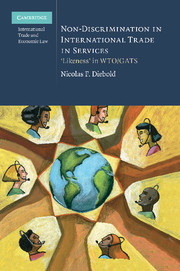Book contents
- Frontmatter
- Contents
- Foreword
- Acknowledgements
- Abbreviations
- List of Cases
- List of Legal Texts
- List of Documents
- Introduction
- PART I Foundations
- PART II Framing the conceptual breadth of ‘likeness’ in GATS
- PART III GATS specific ‘likeness’ issues
- 9 The scope of GATS rules on non-discrimination
- 10 ‘Likeness’ across ‘services’ and ‘suppliers’
- 11 ‘Likeness’ across ‘methods’ and ‘modes’ of supply
- 12 Concluding summary: merged test and crossover ‘likeness’
- PART IV Methodology for the ‘likeness’ analysis in GATS
- Bibliography
- Index
12 - Concluding summary: merged test and crossover ‘likeness’
Published online by Cambridge University Press: 10 January 2011
- Frontmatter
- Contents
- Foreword
- Acknowledgements
- Abbreviations
- List of Cases
- List of Legal Texts
- List of Documents
- Introduction
- PART I Foundations
- PART II Framing the conceptual breadth of ‘likeness’ in GATS
- PART III GATS specific ‘likeness’ issues
- 9 The scope of GATS rules on non-discrimination
- 10 ‘Likeness’ across ‘services’ and ‘suppliers’
- 11 ‘Likeness’ across ‘methods’ and ‘modes’ of supply
- 12 Concluding summary: merged test and crossover ‘likeness’
- PART IV Methodology for the ‘likeness’ analysis in GATS
- Bibliography
- Index
Summary
Chapters 9 and 10 of part III first analysed the rationale and consequences for extending the rules of non-discrimination in GATS to the service supplier as a natural or legal person. The main reason lies in the fact that the service is oftentimes inseparable from the supplier and requires instant consumption. Consequently, Members have the possibility to distort trade in services either by putting the supply of the foreign service to a disadvantage or by discriminating directly against the foreign supplier in its capacity as an individual or enterprise. It was thus necessary to include the ‘supplier’ as beneficiary of non-discrimination, which in turn raises a number of interpretative difficulties. According to the language used in GATS, Members are obliged to treat ‘foreign services and service suppliers’ no less favourably than domestic services and suppliers as well as those from other Members. For an analysis of this obligation, it is necessary to clearly distinguish between the two elements of ‘treatment’ and ‘likeness’. Chapter 10 submits that with regard to the element of ‘treatment’, the distinction between the service and the supplier has no consequences. Any treatment of the service inevitably affects the supplier, and vice versa. Thus, the question whether the GATS non-discrimination obligations require ‘less favourable treatment’ of the service and the supplier or just one of the two becomes moot.
- Type
- Chapter
- Information
- Non-Discrimination in International Trade in Services‘Likeness' in WTO/GATS, pp. 238 - 242Publisher: Cambridge University PressPrint publication year: 2010



